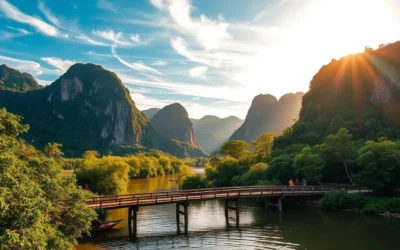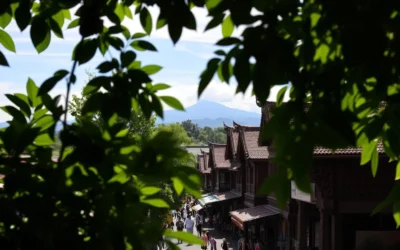Did you know that Sukhothai, an ancient city in Thailand, is home to over 190 historical sites, including the UNESCO World Heritage Site of Sukhothai Historical Park? Planning your visit to this cultural gem requires more than just a curiosity about its rich history; it demands a strategic approach to navigating its climate.
Understanding the local weather patterns is crucial for a comfortable and enjoyable experience. Sukhothai experiences three distinct seasons: cool, hot, and rainy, each with its unique advantages and challenges. By determining the best time to visit, you can explore ancient ruins and cultural sites in optimal weather conditions.
This comprehensive guide will walk you through the ideal months to plan your trip, taking into account temperature preferences, rainfall patterns, and tourist density. Whether you’re looking to avoid crowds, secure better accommodation rates, or experience specific cultural events, timing your visit strategically can make all the difference.
Understanding Sukhothai’s Climate Patterns
To plan your trip to Sukhothai effectively, it’s essential to grasp its climate patterns. Sukhothai, located in north-central Thailand, experiences a tropical savanna climate with pronounced wet and dry seasons.
Geographic Location and Its Impact on Weather
Sukhothai’s geographic location significantly influences its climate. The city’s elevation contributes to temperature variations throughout the year, though it remains relatively warm even during the “cool” months. The weather conditions in Sukhothai are characterized by high temperatures and humidity fluctuations.
Three Distinct Seasons Overview
Sukhothai experiences three distinct seasons: the cool season from November to February, the hot season from March to May, and the rainy season from June to October. The temperature varies from 65°F to 99°F over the course of the year.
| Season | Months | Temperature Range |
|---|---|---|
| Cool | Nov – Feb | 65°F – 75°F |
| Hot | Mar – May | 85°F – 99°F |
| Rainy | Jun – Oct | 75°F – 90°F |
![]()
Understanding these climate patterns is crucial for planning activities and packing appropriately for your visit. The city’s weather directly impacts the comfort level for exploring outdoor archaeological sites.
The Cool Season: November to February
Travelers flock to Sukhothai during the cool season, from November to February, to enjoy the region’s rich cultural heritage in comfortable weather. This period is characterized by pleasant temperatures and lower humidity, making it the best time to explore the ancient ruins and historical sites.

Temperature and Humidity Levels
During these months, you can expect daytime temperatures to range from 75°F to 89°F (24°C to 32°C), while cooler evenings drop to around 65°F to 70°F (18°C to 21°C). The humidity levels are significantly lower, creating a more comfortable environment for outdoor exploration without the excessive sweating common in other seasons.
Rainfall Expectations
Rainfall is minimal during the cool season, with December and January being the driest months of the year. You can expect virtually no precipitation on most days, making it ideal for sightseeing and outdoor activities.
Tourist Experience During These Months
The cool season coincides with the peak tourist season, as visitors flock to experience the pleasant weather and clear skies perfect for photography and sightseeing. The comfortable temperatures make it ideal for cycling around the historical park, a popular way to explore the ancient ruins. Nighttime activities are particularly enjoyable during these months, with many outdoor dining options and evening light shows at historical sites.
- The cool, dry air provides excellent visibility for appreciating the architectural details of the ancient temples and monuments.
- While accommodation prices tend to be higher during this peak season, the superior weather conditions often justify the additional expense for many travelers.
The Hot Season: March to May
As March arrives, Sukhothai enters its hot season, a period characterized by extreme temperatures and changing humidity levels. This season lasts for approximately 1.9 months, from March 10 to May 5, with average daily highs exceeding 97°F.
Temperature Highs and Comfort Levels
During the hot season, temperatures in Sukhothai reach their peak in April, with average highs soaring to 99°F and lows rarely dropping below 80°F. The intense heat can make midday exploration of historical sites challenging. To stay comfortable, visitors often plan their days around the heat, exploring early in the morning and late in the afternoon.
Precipitation Patterns
Despite the increasing heat, precipitation remains relatively low during March and early April. However, as the season progresses towards May, rainfall begins to increase, signaling the transition to the rainy season. Visitors should be prepared for occasional rain showers towards the end of April.
Pros and Cons of Visiting During Peak Heat
Visiting Sukhothai during the hot season has its advantages and disadvantages. On the plus side, tourists can enjoy lower accommodation rates and fewer crowds compared to the cool season. The hot season also coincides with significant Thai festivals, such as Songkran in mid-April, offering unique cultural experiences. However, the extreme heat can be a challenge, making it essential for visitors to stay hydrated and plan their activities carefully.

To make the most of your visit, consider exploring the historical sites during the cooler parts of the day and staying hydrated. The intense sunshine also provides excellent photography opportunities during the golden hours.
The Rainy Season: June to October
Visiting Sukhothai during the rainy season, from June to October, offers a distinct experience with its lush greenery and serene atmosphere. Although this period is characterized by occasional showers, the landscape transforms dramatically, enveloping historical ruins in a vibrant, verdant cloak.
Rainfall Patterns and Intensity
The rainy season in Sukhothai spans from June to October, with the monsoon bringing regular precipitation that peaks in August and September. During this period, Sukhothai receives approximately 80% of its annual rainfall, with September being the wettest month, averaging 7.8 inches of precipitation and about 17 rainy days. Notably, the rainfall patterns typically involve short, intense afternoon or evening downpours lasting 1-3 hours, often followed by clearing skies.
- The wetter season lasts 5.9 months, from April 28 to October 25.
- September is the month with the most rain in Sukhothai.
- The rainy period of the year lasts for 9.0 months.
Temperature and Humidity Considerations
Temperatures during the rainy season remain warm, ranging from 75°F to 90°F (24°C to 32°C). However, the high humidity, often exceeding 80%, can make it feel hotter and more uncomfortable. The increased moisture during this season can make the stone monuments appear more vivid, with moss and lichen adding character to the ancient structures.
Travel Implications During Monsoon Months
Travel during the rainy season offers several advantages, including substantially lower accommodation rates (often 30-50% less than peak season), fewer tourists at major attractions, and a more authentic local experience. However, there are practical challenges to consider, such as occasional flooding in low-lying areas, muddy conditions at archaeological sites, and the need for flexible itineraries that can adapt to sudden weather changes. Morning hours typically offer the best chance for dry exploration, as rainfall most commonly occurs in the afternoon and evening.

Sukhothai, Thailand: Best Months for a Weather-Savvy Trip
To experience Sukhothai at its best, it’s crucial to choose the right time of year for your trip. The city’s historical sites and cultural heritage are more enjoyable when the weather is favorable.
Prime Months for Comfortable Exploration
The best time to visit Sukhothai is from late November to early February, offering a perfect balance of comfortable temperatures, minimal rainfall, and lower humidity levels. December and January are particularly ideal, with average daily temperatures ranging between 75°F and 87°F (24°C to 31°C) and virtually no rainfall. For travelers seeking fewer crowds, the shoulder months of November and February provide slightly higher temperatures but still very comfortable conditions.
You can plan your trip according to your priorities. If you’re looking for the best weather, December and January are the months to visit. If you’re on a budget, consider the early rainy season (June) or late rainy season (October) for lower prices and fewer visitors.
Weather-Based Travel Calendar
A weather-based travel calendar for Sukhothai highlights distinct advantages for different types of travelers. For instance, photography enthusiasts might prefer November for its post-rain greenery and clearing skies, while budget travelers would benefit most from June or September bookings.
| Month | Weather Conditions | Best For |
|---|---|---|
| November | Post-rain greenery, clearing skies | Photography enthusiasts |
| December, January | Comfortable temperatures, minimal rainfall | General tourists |
| June, September | Lower prices, fewer visitors | Budget travelers |
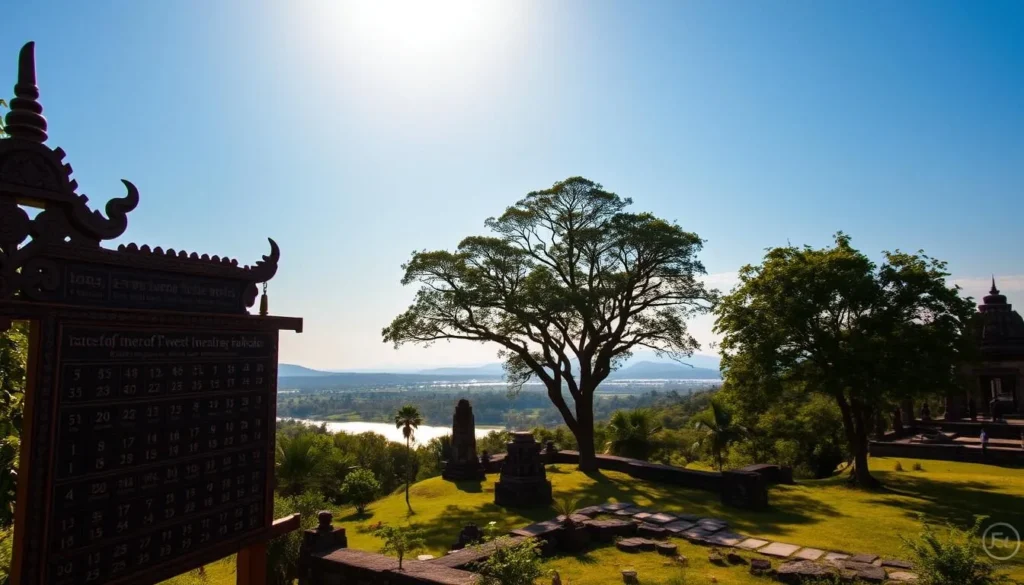
Shoulder Season Advantages: March-April and October-November
Sukhothai’s shoulder season, spanning March to early April and October to November, presents numerous advantages for travelers seeking a balance between weather conditions and crowd levels. During these periods, you can enjoy a more serene experience at Sukhothai’s historical sites.
Weather Characteristics of Transition Months
The transition months offer a mix of weather conditions. In March and early April, temperatures gradually increase, but rainfall and humidity remain relatively low, making morning and evening explorations comfortable. October and November mark the transition from the rainy to the cool season, with decreasing precipitation and moderating temperatures.
| Month | Temperature Range | Precipitation |
|---|---|---|
| March | 25-35°C | Low |
| April | 28-38°C | Low |
| October | 24-32°C | Moderate |
| November | 22-30°C | Low |
Benefits of Visiting During Less Crowded Periods
Visiting Sukhothai during the shoulder season offers several benefits, including significant cost savings with accommodation rates typically 20-30% lower than during peak season. You can also enjoy a more peaceful exploration of popular sites like Sukhothai Historical Park, and capture less crowded photographs. The lush, green landscapes in October and the comfortable temperatures in early March add to the appeal.
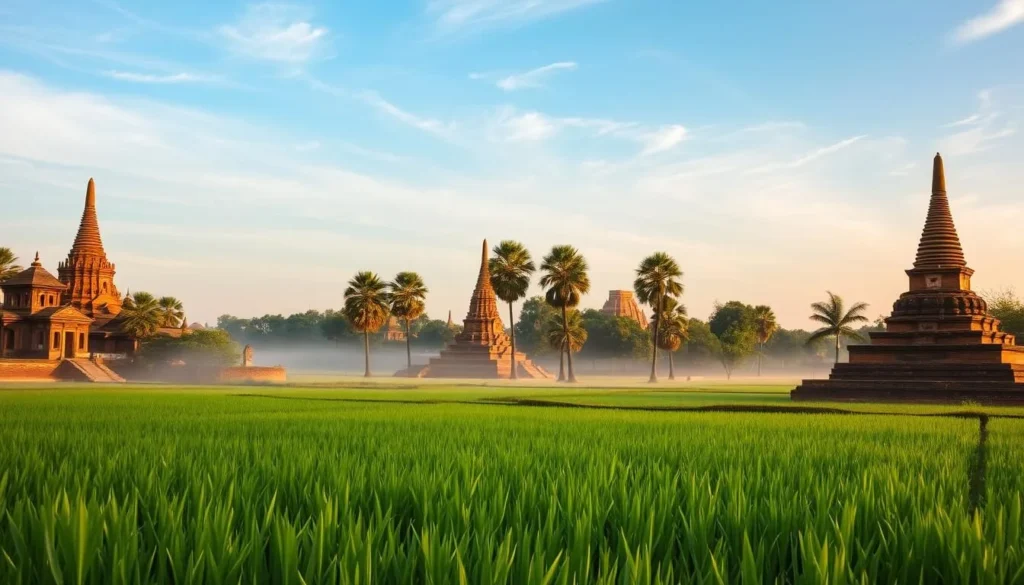
Practical Weather Preparation Tips for Sukhothai Visitors
Understanding and preparing for Sukhothai’s seasonal weather variations is crucial for a successful trip. The city’s climate can significantly impact your travel experience, from exploring ancient temples to enjoying the natural scenery.
Packing Essentials Based on Season
Packing the right clothing and accessories based on the season can greatly enhance your comfort. For the cool season (November-February), pack lightweight clothing and a light jacket or sweater for cooler evenings. During the rainy season (June-October), quick-dry fabrics and waterproof gear are essential. For the hot season (March-May), prioritize breathable clothing and sun protection.
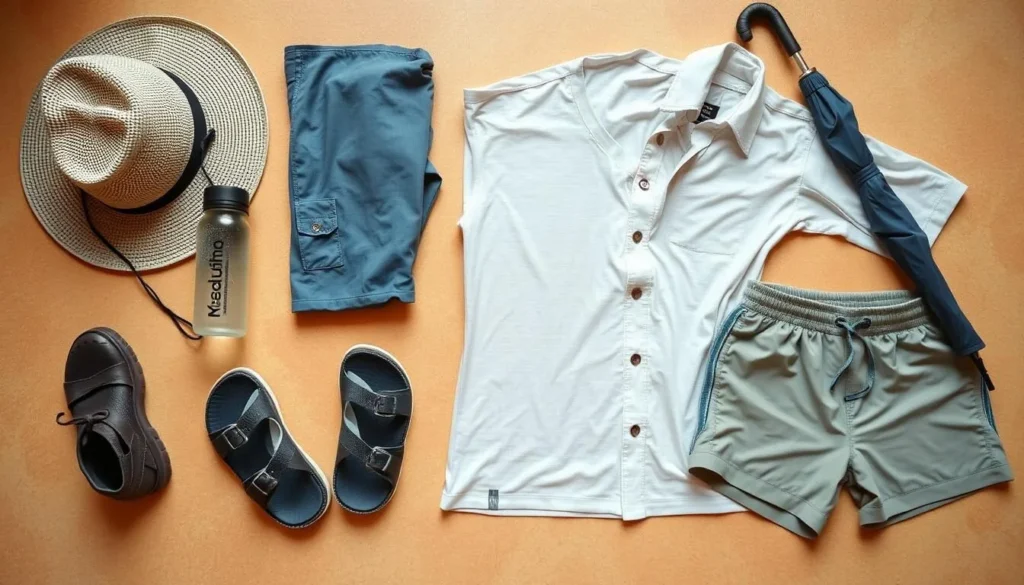
Adapting Your Itinerary to Weather Conditions
Being flexible with your itinerary can help you make the most of your visit. During the hot season, plan outdoor activities for the early morning or late afternoon to avoid the peak heat. In the rainy season, schedule indoor activities for afternoons when rain showers are most likely.
Health Considerations in Different Seasons
Different seasons bring different health concerns. During the hot season, be mindful of heat exhaustion and dehydration. In the rainy season, take precautions against mosquito-borne illnesses. Even in the cool season, don’t forget to protect yourself from the sun.
By being prepared and adapting to Sukhothai’s weather, you can ensure a more enjoyable and stress-free trip.
Conclusion: Making the Most of Your Sukhothai Visit Year-Round
As a UNESCO World Heritage site, Sukhothai’s historical and architectural beauty is a constant, but the experience of visiting varies greatly with the seasons. While November through February offers the most pleasant weather conditions, with comfortable temperatures and minimal rainfall, each season provides its own unique advantages and challenges for visitors.
The rainy season (June-October) transforms Sukhothai into a lush landscape, offering a different perspective on the ancient ruins. Budget-conscious travelers can benefit from lower accommodation rates during the shoulder or rainy months. Regardless of when you visit, adapting to the daily weather patterns will enhance your experience. Ultimately, the best time to visit Sukhothai depends on your priorities, whether ideal weather, budget, or cultural experiences.
—
The above is subject to change.
Check back often to TRAVEL.COM for the latest travel tips and deals.


